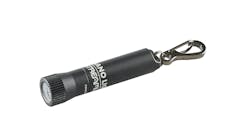Almost every automotive or truck technician has worked in a flat rate pay environment at one time or another. I am no exception. The idea behind a flat rate pay plan incites us to be the fastest we can be. On that plan, the faster we get the job done, the more money we stand to make. It is this type of remuneration that prompts us to constantly think ahead to what our next move is (while still performing in the present) or suffer the consequences of lower pay for production that’s less than optimal. Increasing our income is one good incentive for us to constantly improve our skills so that there is a minimal amount of time wasted when we perform repairs.
Over time, smart technicians learn lots of ways how to save time. For example, we might choose one tool over another, like using an air ratchet instead of a non-powered tool, to decrease the time it takes us to do the job. It is for the very same reason that I’ll reach for a Digital Storage Oscilloscope (DSO) instead of a Digital Volt & Ohm Meter (DVOM) when I have to perform certain electrical diagnostic routines. In those cases, the DSO delivers more information to me in a shorter period of time than a DVOM will, thereby enabling me to decrease my diagnostic time and to increase my diagnostic accuracy and productivity.
A DVOM can tell you if a WSS is outputting a signal, but it would never catch this defective signal (tone ring is damaged). This defect can be the cause of unwanted ABS activation.
Now, I won’t argue there are times when a DVOM is all I need, and that using a scope during those instances would be more time consuming, be more cumbersome, etc. I admit, there are tasks where employing the use of a scope would be like trying to kill mosquitoes with a cannon. What I will insist though is that I save time when I use a DSO if for example, I need to use more than just one part of Ohm’s law to find a problem, or need to analyze a particular part of a circuit in detail, or want to compare multiple signals at the same time (the list can go on). Let’s explore some examples of how a DSO might save us some time.
First, consider a simple one-speed radiator cooling fan circuit that’s comprised of a PCM-controlled relay, the fan itself and of course all the wiring that connects the components. The relay has four electrical connections: two for the control side and two for the load side. When the relay is activated, what tests can we perform?
If we were to choose a DVOM, we could read the average of both the control-side voltages (Supply & Ground) and both of the load-side voltages (Supply & Feed) on each “leg” of the relay and we could read the average amperage flowing through each side of the relay if we plug in a current probe. Notice I said the average of those readings; that is important to remember. We can also perform voltage drop tests on all four circuits one at a time. If instead, we chose to use a scope on that radiator fan circuit, we could do all of the same tests. Naturally, the time it would take to perform those tests, whether we used a DVOM or a DSO, would depend on many factors but would be fairly equal.
Now here’s the exciting part (at least to me it is). If we did decide to use a DSO, we could perform even more tests and not take much more time to do them. For example, if while we are looking at the average amperage of the cooling fan motor and then changed some settings, we could zoom in to inspect the integrity of the armature windings in the motor itself. If one or more of the armature windings was shorted to ground, shorted to itself or if it had an open circuit, we would be able to see that on the display. But any of those situations could be averaged into the DVOM readout, and you might never know they existed. We can say averaging the readings will mask the problem.
What can we learn from the in-rush amperage reading of a motor? In-rush amperage can be described as the amount of amperage needed to get an armature rotating. This measurement is an important part of the calculations used to determine the state of health for an electric motor. There are lots of rule-of-thumb specifications I’ve heard over the years for what is considered acceptable but the actual specification will differ depending on the application for the motor (radiator cooling fan, starter, whatever) and may vary according to what it is installed on.
Only a scope allows you to check the electrical health of a fuel pump’s windings and catch a problem before the pump actually fails.
In any case, it is nearly impossible to accurately measure the inrush amperage when we use a DVOM, even when it’s set to its most sensitive measuring capability. The inaccuracy is attributed in part to limitations in the sampling rate of the tool, such as at what point the tool takes its samples when compared to when the peak amperage occurred. The way a DVOM averages its samples will most likely result in its maximum reading to display differently each time you try to measure the inrush amperage. By the way, you do know the fastest sampling occurs when selecting the Min/Max function on your DVOM, right? That’s just a reminder for those of you who might have forgotten.
Anyway, other tests on this circuit the DSO can do (without taking much more time) are the load-side relay contact integrity test and the control-side suppression diode test. When the fan relay contacts close we can measure the time it takes to reach the maximum “in-rush” of current flow. This time span might be extended indicating high resistance between the relay contacts and that may be caused by relay contacts that are burned, have carbon deposits or even (and I’ve seen this) ants between them.
At the time the relay’s turned off a spike is usually seen in the control-side oscilloscope voltage waveform. This spike is induced by the relay’s collapsing magnetic field that’s created by the energizing of the relay winding. If the suppression diode is faulty or the spikes are severe enough, they can wreak havoc on the computer that controls the relay and sometimes cause anomalies in other systems as well. The symptoms may include stalling, stuttering performance complaints, instrumentation flickering and more. Since the spikes typically last for just a split second, they are elusive to the technician attempting to address those strange customer complaint(s) when using a DVOM. It is almost a certainty that the cause is impossible to find without a DSO.
More Opportunity
There are many more tests a scope can do on this circuit that a DVOM cannot but you get the idea.
Even glitches in magneto-resistive wheel speed sensors can be found using the scope. This sensor’s tone ring has a broken tooth.
Here’s another situation you might be familiar with. Let’s consider a simple two-wire permanent magnet generator (PMG) sensor, like a wheel speed sensor. If we’re addressing an Antilock Braking System (ABS) complaint, we’ve been taught to use our DVOM to test the resistance of the windings and if within specifications, measure the AC voltage produced when the wheel is spinning. We can even measure the frequency generated if our meter allows. Lastly, we can compare these readings to the other sensors on the vehicle one at a time, and hope to find a difference. In theory, if all these tests pass then we are to assume the sensor is good (don’t we just love to assume?).
Alternatively, we can perform those same tests using almost any DSO (some might require a certain creativity to do so) and get identical test results, but the DSO can give us so much more information. On top of what the DVOM presents, we can see if there are any reluctor teeth missing while we measure the AC voltage simply by adjusting our settings to closely examine each pulse that gets generated by a reluctor tooth passing near the pick-up. Once a full 360-degree tire revolution is displayed on the screen, it becomes obvious where one or more pulses have not been generated as expected (missing tooth). A missing tooth can be interpreted by the ABS as a skid or wheel lock.
We also can see if the sensor is close enough to the reluctor. In most instances where permanent magnet generators are used as sensors, the proximity to the reluctor is important. It becomes obvious when rust build-up on the sensor mounting surface has distorted how the sensor is positioned in relation to the reluctor when using a DSO. When positioned further away from the reluctor (or off-center), it won’t produce as much AC voltage as the other sensors. If so, it may be too low a voltage at slower speeds, meaning too weak a signal, to rely on for ABS decision making. Therefore, the weaker signal may not meet the ABS electronic control unit’s “acceptable threshold value” when comparing it to the other sensors and set a code. This might also result in an “unintended ABS activation at slower speeds” complaint. It’s not because the particular wheel speed sensor’s signal has been dramatically affected by the change, but when comparing its signal to the others on that vehicle, the amplitude generated is far less than all the rest.
Like graphing scan data to see anomalies, a scope can be used to “graph” an electrical input to do the same thing.
Now, if we were to drive the vehicle in a straight direction while displaying all of the wheel speed sensors on our scope screen, we could compare them to each other. Theoretically, since all our wheel and tire combinations are the same (you did do a visual inspection first, right?) then all four will rotate at the same speed and our wheel speed sensors should all produce the same signal. If for some reason one is not like the others (like the replacement CV axle having a different number of reluctor teeth) it will be readily evident by its pattern not matching the others. This situation usually results in an ABS Diagnostic Trouble Code (DTC) that when following the chart, most likely will lead to unnecessarily replacing components (read: wasted time). The fact is, we can compare this sensor to the others on the vehicle – at the same time – to see if its signal is the same or not when we use an oscilloscope, but can’t if we’re using a DVOM.
Here I have described many tests that can be done on two very simple and very common circuits. Can you imagine what can be done on more complex systems?
Do you ever do repairs on vehicles that came from other shops? I do and some of them are body shops. It’s common for me to diagnose damaged sensors that look perfectly fine on the outside. Sometimes they will pass all the criteria when tested using a DVOM but I can tell you, their signal will be faulty when examined with an oscilloscope. The damage that isn’t obvious can be observed dynamically – that is, when driven – that won’t show up when stationary. Like, we can see if a tone ring (reluctor) is bent or misshaped by the pattern increasing and decreasing as the wheel spins. It’s the not-so-obvious stuff that becomes obvious when we use a scope.
I promised not to present any exotic examples so I won’t take this opportunity to delve into the two-wire Digital Wheel Speed Sensors (Magneto-Resistive) and how a bad wheel bearing may affect its signal. I’m sure though, that I just planted a seed.
Sometimes cooling fans don’t come on when they are supposed to. Checking the health of the motor using a scope may provide the clues you need to determine why.
What about the wiring repairs you’ve seen? Sometimes folks can get pretty creative when it comes to their definition of wiring repair. When it comes to PMG sensors, it becomes much more important to follow proper repair procedures and proper routing. I remember being called into a shop for a “stalls over 20 mph” complaint after an “off-road experience” (that’s how it was described to me). This Buick LeSabre’s Vehicle Speed Sensor harness had been repaired and re-routed in such a way the ignition system influenced the signal (even while sitting still). By the time the vehicle reached 20 mph, the scanner showed vehicle speeds of 123 mph. When that happened the PCM then governed the engine down just as its programming told it to.
Could a DVOM have found the cause? Yes, I believe in this case it could have. After what’s been written in this article and if approached with this scenario, would you have grabbed your oscilloscope or your DVOM first?
In conclusion, I feel the DVOM can’t give us many of the test results that a DSO can, doesn’t report complete system integrity without performing time-consuming component-level tests and sometimes masks its results leading us to waste our time. Remember, having worked Flat-Rate during most of my career, I want to get the most information in the shortest period of time so that the job gets done quicker; so that I get the car out, get the next one in and make a living. I want to “Git ‘er DONE”.
So what if a few mosquitoes get harmed in the meantime?
Subscribe to Motor Age and receive articles like this every month…absolutely free. Click here







